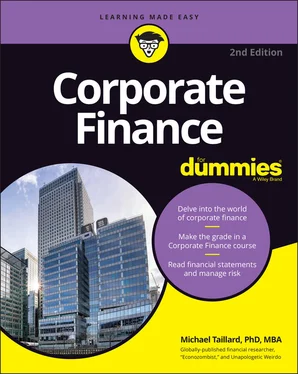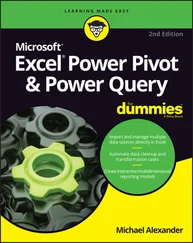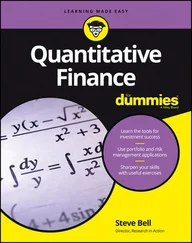Michael Taillard - Corporate Finance For Dummies
Здесь есть возможность читать онлайн «Michael Taillard - Corporate Finance For Dummies» — ознакомительный отрывок электронной книги совершенно бесплатно, а после прочтения отрывка купить полную версию. В некоторых случаях можно слушать аудио, скачать через торрент в формате fb2 и присутствует краткое содержание. Жанр: unrecognised, на английском языке. Описание произведения, (предисловие) а так же отзывы посетителей доступны на портале библиотеки ЛибКат.
- Название:Corporate Finance For Dummies
- Автор:
- Жанр:
- Год:неизвестен
- ISBN:нет данных
- Рейтинг книги:4.5 / 5. Голосов: 2
-
Избранное:Добавить в избранное
- Отзывы:
-
Ваша оценка:
- 100
- 1
- 2
- 3
- 4
- 5
Corporate Finance For Dummies: краткое содержание, описание и аннотация
Предлагаем к чтению аннотацию, описание, краткое содержание или предисловие (зависит от того, что написал сам автор книги «Corporate Finance For Dummies»). Если вы не нашли необходимую информацию о книге — напишите в комментариях, мы постараемся отыскать её.
Corporate Finance For Dummies,
Corporate Finance For Dummies,
Corporate Finance For Dummies — читать онлайн ознакомительный отрывок
Ниже представлен текст книги, разбитый по страницам. Система сохранения места последней прочитанной страницы, позволяет с удобством читать онлайн бесплатно книгу «Corporate Finance For Dummies», без необходимости каждый раз заново искать на чём Вы остановились. Поставьте закладку, и сможете в любой момент перейти на страницу, на которой закончили чтение.
Интервал:
Закладка:
Preferred stock: If you hold preferred stock in a corporation, you get your dividend payouts in full before common shareholders get even a dime. That holds true for liquidation as well. As with common stock, being a preferred shareholder gives you the right to get information from a company. But the key difference between common and preferred shareholders is that preferred shareholders don’t have voting rights. So, although they have a right to the ownership and success of a company, they have no voice or control over the actions the company takes.
Treasury stock: When a company issues common shares of stock, it has the opportunity to repurchase those shares on the secondary market as any investor does. When a company does so, those common shares become treasury shares. The stock itself hasn’t changed at all; it’s just owned by the company that the stock represents. So, in essence, the company owns itself, which is only one step away from becoming completely self-aware and destroying us all! Companies tend to do this (buy treasury stock, not destroy us all) because they can generate income in the same way that many investors do, but buying treasury stock also allows them to manage their stock price more effectively.
 Another stock-related term you need to know, though it isn’t a type of stock per se, is stock split. A stock split occurs when a company takes all of its common shares of stock and splits them into pieces. For example, say a person had one share of stock worth $10 before a stock split. After the split, that person has two shares of stock each worth $5. Companies use stock splits to increase the liquidity of stock shares, making them easier to buy and sell and, in the long run, driving up the total value. Note that this process can easily backfire if there isn’t already a demand for a company’s stock from people who would buy it at the cheaper post-split rate.
Another stock-related term you need to know, though it isn’t a type of stock per se, is stock split. A stock split occurs when a company takes all of its common shares of stock and splits them into pieces. For example, say a person had one share of stock worth $10 before a stock split. After the split, that person has two shares of stock each worth $5. Companies use stock splits to increase the liquidity of stock shares, making them easier to buy and sell and, in the long run, driving up the total value. Note that this process can easily backfire if there isn’t already a demand for a company’s stock from people who would buy it at the cheaper post-split rate.
Having Your Wish Granted
Depending on the type of industry you are in, and the interests of those with money, you might be eligible for grants. There are grants from different government organizations, grants from other businesses, grants from universities, grants from special interest groups, and so forth. Generally, they will tell you exactly the kind of work/project they are willing to provide grant function for, in addition to the requirements and process for applying. Ideally, you have an experienced grant writer assist you, but if not, then be prepared to present extensive budgeting and operating information and explain how you can best meet the needs of the organization providing the grant money.
 Options for raising money — like private investors, angel investors, crowdsourcing, and so on — are exciting and popular paths for small businesses to pursue, but provide almost no real opportunities unless you first develop relationships within those social circles. It’s best to stick with traditional methods of raising capital until your story becomes more well known among these unorthodox routes.
Options for raising money — like private investors, angel investors, crowdsourcing, and so on — are exciting and popular paths for small businesses to pursue, but provide almost no real opportunities unless you first develop relationships within those social circles. It’s best to stick with traditional methods of raising capital until your story becomes more well known among these unorthodox routes.
Part 2
Making a Statement
IN THIS PART …
Learn the balance sheet to comprehend what a company is really worth.
Use the income statement to understand a corporation's income and costs.
Utilize the statement of cash flows to see how different activities earn or spend money.
Perform the vital basic calculations to make decisions based on the information in corporate financial statements.
Comprehend financial statement calculations that are important to investors and lenders.
Chapter 4
Staying Balanced
IN THIS CHAPTER
 Introducing what’s what on the balance sheet
Introducing what’s what on the balance sheet
 Examining assets, liabilities, and owners’ equity
Examining assets, liabilities, and owners’ equity
 Understanding how you can use the balance sheet
Understanding how you can use the balance sheet
For every give, there is a take. For every expenditure or liability, there is an asset of equivalent value. All of business finance must be in balance, and this is reflected nowhere better than on the balance sheet. The balance sheet is a financial report that’s useful to anyone who has even the slightest interest in a business, including management, investors, lenders, business students, union representatives, and all other stakeholders. In short, the balance sheet includes important stuff, so pay attention to this chapter!
Introducing the Balance Sheet
The Securities and Exchange Commission (SEC) requires that all corporations maintain a balance sheet and highly recommends that any business keep one (the distinction being that corporations are publicly-owned companies that are legally required to fulfill these reporting obligations to its shareholders and other regulators).
After all, the SEC’s main purpose is to illustrate the exact value of a company in the very moment that the data are collected. Unlike other financial reports, the balance sheet doesn’t compile data over a period of time. Instead, it reports the value of all the assets the company currently has, divided into relevant categories, and then also includes the value of the company’s liabilities and owners’ equity, each divided in a manner similar to assets.
Here’s the basic formula for the balance sheet:
Assets = Liabilities + Owners’ equity
So the total value of all assets equals the total value of all liabilities plus all owners’ equity. If the two sides of the equation don’t balance, then someone did something wrong, and it’s time for some no-holds-barred combat accounting! Hooah!
Evaluating the Weights on the Balance Scale
Everything of value in a company falls into three primary categories. Each of these categories represents a portion of the balance sheet:
Assets: Assets include anything of value that currently belongs to the company or is currently owed to the company. Remember that the company purchases all assets by using capital acquired by incurring debt and selling ownership, so the total assets must balance with the cumulative totals of the other two portions of the balance sheet (see the next two bullets).
Liabilities: Liabilities include the value of all the company’s debt that must be repaid.
Owners’ equity: Owners’ equity includes all the value that the company holds for its stockholders.
Each portion of the balance sheet begins with the things that are the most liquid at the top. In other words, the top of each portion includes the things that either must be or otherwise can be converted to cash the quickest. As you make your way down each portion, the items included gradually become either decreasingly liquid or require repayment for longer periods of time.
 Liquidity refers to the relative ease with which assets are turned into cash. Cash is clearly more liquid than capital assets like machinery, which must be sold to acquire cash, for example. When a company has become unable to turn their assets into cash in a time period necessary to pay their bills and continue operations, the company is said to be insolvent .
Liquidity refers to the relative ease with which assets are turned into cash. Cash is clearly more liquid than capital assets like machinery, which must be sold to acquire cash, for example. When a company has become unable to turn their assets into cash in a time period necessary to pay their bills and continue operations, the company is said to be insolvent .
Интервал:
Закладка:
Похожие книги на «Corporate Finance For Dummies»
Представляем Вашему вниманию похожие книги на «Corporate Finance For Dummies» списком для выбора. Мы отобрали схожую по названию и смыслу литературу в надежде предоставить читателям больше вариантов отыскать новые, интересные, ещё непрочитанные произведения.
Обсуждение, отзывы о книге «Corporate Finance For Dummies» и просто собственные мнения читателей. Оставьте ваши комментарии, напишите, что Вы думаете о произведении, его смысле или главных героях. Укажите что конкретно понравилось, а что нет, и почему Вы так считаете.












